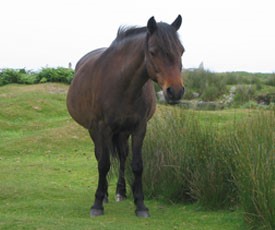 |
|
Lundy Ponies were first developed on Lundy Island in England
in 1928, when the owner of the island, Martin Coles Harman, introduced 34 New
Forest pony mares, eight foals, and a Welsh Mountain B strawberry roan
stallion. Diana Keast, his daughter, explained why he chose to cross these
breeds: "He wanted ponies with a bit of style and height. Dartmoor and
Exmoor ponies were nearer and more convenient - after all he had to charter a
special train to bring the ponies from Lyndhurst - but they wouldn't have had
the height he wanted." The Welsh stallion died only a year after arriving
on the island, having sired just one foal - a colt called Pepper. Luckily this
first "Lundy pony" grew into an upstanding stud stallion, creamy dun
with a black mane and tail. By the 1930’s there were so many ponies roaming the
island that about 50 were rounded up and sold on the mainland. During world war
II there was no way of shipping ponies from the island and the herd reached
nearly 100. There was constant warring among the stallions so that in 1944 a
number had to be put down.
The pony herd was moved from the island in 1980 and taken to
Cornwall, where it continued to breed. Some were also taken to New Devon. In
1984, the Lundy Pony Breed Society formed to oversee the breed. The Society
later decided to return some of the mares and foals to the island of Lundy.
Due to the harsh environment of the island, with poor
vegetation and severe weather, the ponies grew to be incredibly tough and
hardy. They typically are dun, roan, palomino, bay, or liver chestnut in color,
and rarely exceed 13.2 hh in height. The ponies have a wide, deep chest,
sloping shoulder, and hard, sound legs. Their necks are usually well-set and
muscular and their backs strong and compact. Lundy Ponies are useful as mounts
for children, as they are both attractive animals and good natured.

